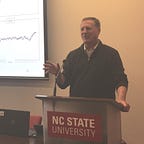Theoretically speaking
“I’m pleased to be known as the father of public relations when the field is taken seriously, like law or architecture.”
— Edward Bernays
It’s no secret that Edward Bernays, the father of PR, grew to become bitterly disenchanted with the profession he brought to life in the 1920s. He had aspired for PR to evolve into a social science, a professional discipline harnessing the powerful influence of media on human behaviors.
By comparing PR to fields like law and architecture, Bernays was trying to raise the bar. Both disciplines require specialized education and are practiced by licensed professionals. PR, on the other hand, had come to be dominated by undisciplined press agents and promoters.
“Public relations today is horrible,” he said in a New York Times interview marking his 100th birthday in 1991. “Any dope, any nitwit, any idiot can call him or herself a public relations practitioner.”
Which begs the question: Moving beyond PR, are there ways to realize Bernays’ dream of elevating the standing of communication as a social science?
I have a theory about that.
Let’s first put something on the table and name it. Theories tend to be abstract, intellectual, impractical. That, to some extent, makes them seem, well, boring. Let’s lean into that. Theories, after all, create the underlying foundations needed to build a discipline or profession.
Consider the physical sciences. For most of us, The Big Bang Theory was a classic television sit-com. For physicists, the big bang represents a shared understanding of the universe.
In the social sciences, theories form paradigms, a shorthand for understanding observable relationships. Theories also provide frameworks for measuring those relationships. In economics, for example, we might base our work on Rational Choice theory.
By comparison, communication in the realm of arts and sciences remains largely an art — some might say a dark art.
In order for communication to evolve as a social science, we need theories that form foundational paradigms and define measurable relationships.
Let’s start with the functional theories. PR practitioners for decades have relied on Agenda Setting theory as a foundation for media measurement. If the media shapes perceptions, so the thinking goes, we can measure perceptions by measuring the media. More specifically, volume and tonality of news are currently the go-to proxies for reach and resonance of news with people. Spoiler alert. Those are two different things.
Working our way to tactical theories, PR over the years has gravitated to Relationship Management theory and the concept of mutually beneficial publics. Some PR pros would go so far as to say the PR function represents the conscience of a company or organization. Assuming that’s true, how do we level that against PR’s reputation for spin? Mutual benefit is, to a great degree, aspirational.
Now let’s get into the strategic theories. This is where we can actually align communications outputs to organizational and social outcomes. Bernays himself operated in this strategic space, unapologetically leveraging the mass media to promote smoking — a campaign he later regretted — and to spearhead development of what became the interstate highway system. That’s Systems Theory, sort of. On the flip side of that coin, news-driven crisis events have corresponded to inverse impacts — cutting sales in half in some cases. That’s Situational Crisis Theory, sort of.
Why sort of? Here’s the rub. When it comes to business, there is a yawning gap between communications outputs and organizational outcomes. Intuitively, we know that news shapes perceptions that people have about a company or brand. But existing theories do not explain that process in ways that are measurable.
Theory in practice
Here’s one way to visualize a theoretical framework that can bridge that gap. On the vertical axis, we can plot communication outputs. Functionally, we communicate by crafting and publishing messages. We then drive those messages through channels — websites, the news media, even advertising — in an attempt to reach our audiences. Ultimately, some of that noise breaks through. Signals.
On the horizontal axis, we can plot communications outcomes. Those outcomes would include media that we generate — news, blogs, ads. Then we would consider stakeholders we reach — customers, supporters, voters. Then, ultimately, we would consider the impacts of the communications on our organizations — companies, causes, or candidates.
To elevate communications as a social science — and to elevate business communicators as disciplined professionals— we can move from this…
…through this …
… to this:
As a practical matter, media monitoring generates functional metrics. Over-extending volume and tonality of traditional and social media by claiming that content data represents consumer perceptions marginalizes communication functions. The executives may not call you out on the research, but they are unlikely to call you in to advise on corporate tactics.
As a practical matter, creating derivatives like ad value equivalence and return on investment marginalize the power of the media, and distract from communication tactics that influences the products we buy, and even candidates we support or causes we endorse.
As a practical matter, market mix modeling was developed to improve the efficiency of ad spends. Relying on multivariate analytics solely to prove the influence of news sells communication strategy short. More on that opportunity cost later.
A closing thought. None of this is meant to be a criticism. Again, the nexus of communication and communication research creates compelling opportunities. Theories have established our understanding of the physical sciences, and elevated practices in the social sciences. In the same way, theories that explain the relationships between Messages and the Media will elevate communication functions. Theories aligning Narratives and Stakeholders will elevate communication tactics. Theories that align stakeholder Reactions to Organizational outcomes will elevate communication strategies.
So how can we put Theory in Practice?
That’s next.
Are you an academic interested in developing a new generation of communication theories that are truly strategic? I have access to data. Let’s talk.
Jim.Pierpoint@HeadlineRisk.com
